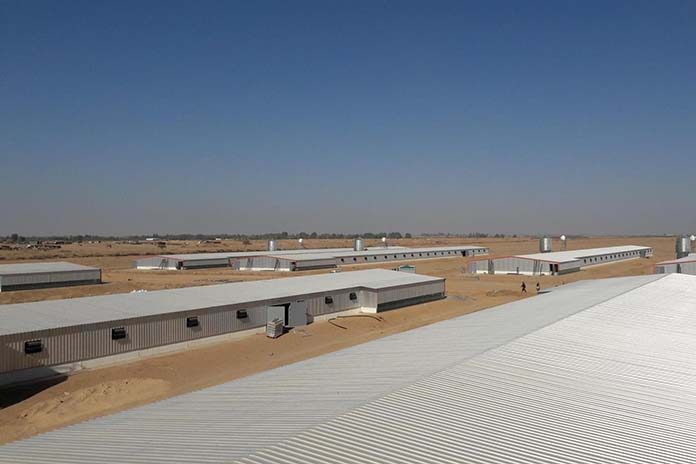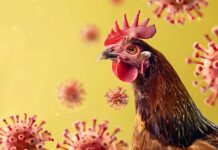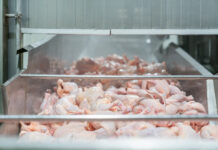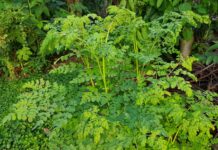
Hot weather can have a detrimental effect on flock performance and in extreme cases cause heat loss. While you cannot control outside weather conditions, you can increase the hours of comfort and reduce the hours of stress on your flock by following some of these tips to improve bird comfort.
Brooding for hot weather issues
- Set brooder temperatures high enough for stoves to Poults may pile if they cannot find the heat source. If stoves will not cycle due to excessive outside temperatures:
- Houses with fans – set a fan to run on
- Curtain-only houses – crack curtains enough to allow in fresh
- Turn down any overhead lights to draw poults in under brooders, if
- Have fresh cool water readily available for
- Check poults frequently soon after delivery to ensure they are settling in and not
- As temperatures cool down at night check for drafts and ensure poults are comfortable and not piling.
Ventilation for hot weather
- Ensure all fans are in working order, belts are tightened and fan housings are kept free of dust. Clean louvers and vent openings frequently as any dust accumulation will reduce air flow.
- Set and activate This is especially critical for barns using tunnel and static pressure ventilation:
- Temperature targets will vary with flock
- Alarms should be tested
- Properly set thermostats on fans, foggers and curtain machines according to flock age and outside temperature
- Direct hanging fans so air flows across the birds and not up to the
- For static pressure barns, remember the goal is to pull enough static pressure for the air to reach the center of the building while still increasing air Not all barns are the same width and will have different requirements. Check with your service technician on recommendations for your barn.
- Set up tunnel ventilated barns in stages based on outside temperatures and bird requirements.
- For curtain sided barns, keep screens clean of dust and Keep perimeter of building clear of tall grass, equipment and any other air flow obstructions.
- Test any foggers or misters prior to use each Nozzles can become clogged; hoses and pipes can become cracked. Dripping nozzles will reduce mist onto birds and create wet spots. Watch for drips and repair as needed.
- Fogger systems should be run at service technician recommendations on temperature and timer Outside humidity can be a factor in when and how long to run foggers for fighting hot weather.
Water
- Ensure all drinkers are in working order to fight hot weather. Adjust drinker height and water depth Consider increasing depth of water in drinkers during summer months to give birds improved access to water.
- In barns with nipple drinkers, flush lines daily to keep bio-film build-up to a Also, check all lines for water to ensure lines are not air locked. Visually check standpipes for proper water pressure.
- Ensure 3-5 PPM free-chlorine reading in last drinker to reduce pathogen load in
- Suggested ORP reading of 650 or
- Flush water lines frequently or use a drip line out the back of the barn during periods of excessive heat to keep water
- Clean water lines in between flocks to reduce bio-film and other pathogens that can build up during the life of a
General
- Check and run automatic generators weekly, as well as fuel and battery
- Farms equipped with automatic curtain drops for power failure should be hooked up and checked weekly.
- Lighting programs may need to be adjusted during periods of excessive Birds may need more light at night so they have the opportunity to recover from the heat of the day and eat and drink while it is cooler.
- Ensure fly control is in place before hot weather Flies are known carriers of diseases. Do not wait until there is a problem to begin a program. Do not assume all products are safe to use with birds present. Check with your service technician on an appropriate program.
- Consider using electrolytes to reduce stress on birds at key Look for electrolyte packs with stabilized vitamin C present. Check with service technician prior to running any product on birds.
- Excessive heat (>85°F / 29°C) – run electrolytes during daylight hours and fresh water overnight.
- Moving birds to grow out – run electrolytes the day before
- Loading birds for processing – run electrolytes 24 hours before
- Consider using a spray-rig to cool birds in naturally ventilated barns during the hottest part of the day. Make sure you start before the hottest part of the day and continue until it begins to cool off in the
- Reduce density for flocks finishing during summer months and hot weather.
- Collect and dispose of mortality properly; failure to do so can increase the risk of spreading certain diseases. Remember that heat speeds up the decomposition process so mortality should be collected
- Keep grass around barns and feed tanks mowed and Tall grass and weeds can hinder ventilation, harbor mice, rats, snakes and bees. Rodents can carry disease into your flock. Snakes and bees are a safety hazard.
- Check birds often on days of excessive heat or hot weather. Ensure all fans and ventilation systems are working. Check water and ensure you have not had any sort of system
- Moving birds should be done early in the day before it gets too Avoid pushing birds too hard or in large groups as piling may result.
- Consider increasing sodium levels in the feed to increase water
- Again, heat stress due to hot weather can be detrimental to performance and details matter when the temperature and humidity are the highest. All of these guidelines are meant to help flocks handle the heat and reduce the Prepare for periods of excessive heat to maintain bird comfort and performance.
From the 2019 Proceedings of the Midwest Poultry Federation Convention.

















